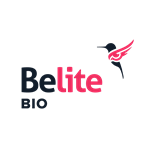- Tinlarebant (a/k/a LBS-008) is Belite Bio’s orally administered tablet intended as an early intervention to slow disease progression in patients affected with Stargardt Disease (STGD1) and Dry Age-related Macular Degeneration (Dry AMD)
- There are currently no approved treatments for STGD1 and Dry AMD
- Currently, a 2-year Phase 2 study in adolescent STGD1 patients is ongoing and a global Phase 3 study in adolescent STGD1 patients (the “DRAGON” study) is recruiting subjects
- 12-month interim data from the ongoing Phase 2 STGD1 study continues to show halting or slowing of lesion growth
- Tinlarebant has been granted Fast Track Designation and Rare Pediatric Disease Designation in the U.S., and Orphan Drug Designation in both the U.S. and Europe for STGD1
SAN DIEGO, Nov. 18, 2022 (GLOBE NEWSWIRE) -- Belite Bio, Inc (NASDAQ: BLTE), a San Diego based clinical stage biopharmaceutical drug development company targeting currently untreatable eye diseases, today announced that, following discussions with the FDA, it has finalized the study design for its planned Phase 3 clinical trial to evaluate efficacy and safety of Tinlarebant (a/k/a LBS-008) in patients with geographic atrophy (GA) associated with Dry AMD.
“We are very excited to initiate our Phase 3 advanced Dry AMD study to bring forward an early intervention, once-a-day oral treatment for patients suffering from visual loss due to Dry AMD. The safety and efficacy of Tinlarebant is currently being evaluated in a Phase 2 study and a Phase 3 study in patients affected by STGD1. Considering that a common cause of disease progression in both GA and STGD1 is characterized by the aberrant accumulation of cytotoxic byproducts of vitamin A, we are optimistic for a positive outcome for Tinlarebant in GA patients,” said Dr. Tom Lin, CEO of Belite Bio.
Phase 3 Advanced Dry AMD Study Outline
- 2-year prospective, randomized (2:1, active:placebo), double-masked, placebo-controlled study designed to assess the efficacy and safety of daily oral Tinlarebant.
- Enrollment expected to begin in the first half of 2023 of at least 300 GA patients across multiple centers globally.
- The primary endpoint will be the change in GA lesion size from baseline to month 24, compared to placebo.
- An interim analysis of efficacy and safety is expected to be conducted at the mid-point of the study.
“Knowing that vision loss will likely occur in patients with more advanced GA, it is crucially important that we intervene early while retinal tissues are still viable to prevent irreversible damage. We are very pleased and quite encouraged that Tinlarebant is being evaluated in a Phase 3 study as a potential non-invasive, oral therapeutic option for patients with GA,” stated Quan Dong Nguyen, MD, MSc, FARVO, FASRS, Professor of Ophthalmology, Professor of Pediatrics, and Professor of Medicine at the Byers Eye Institute and Stanford University.
About Tinlarebant (a/k/a LBS-008)
Tinlarebant is a novel oral therapy intended as an early intervention to prevent the accumulation of vitamin A-based toxins (bisretinoids) that cause STGD1 and contribute to pathogenesis in Dry AMD. Bisretinoids are formed as by-products of vitamin A in the visual cycle. Tinlarebant works by reducing the level of serum RBP4, the carrier protein which transports the retinol to the eye. By modulating the amount of retinol entering the eye, Tinlarebant reduces the formation of bisretinoids to preserve the health of retinal tissues.
About Stargardt Disease
STGD1 is the most common inherited retinal dystrophy (causing blurring or loss of central vision) in both adults and children. The disease is caused by a dysfunctional retina-specific protein (ABCA4) which causes an early, aberrant accumulation of cytotoxic byproducts of vitamin A in the retina leading to retinal cell death and progressive loss of vision. There are currently no approved treatments available for STGD1.
About Dry Age-related Macular Degeneration
Dry AMD is a leading cause of vision loss in the U.S. Dry AMD has a heterogenous etiology but shows a pathophysiology that is similar to that of STGD1 in which the excessive accumulation of cytotoxic bisretinoids leads to retinal cell death and loss of vision. There are an estimated 11 million patients with dry AMD in the U.S. and over 196 million patients worldwide with an estimated global direct healthcare cost of US$255 billion. An advanced vision-threatening form of dry AMD is Geographic Atrophy (GA), which is characterized by progressive atrophy of the retinal pigment epithelium and underlying choriocapillaris, followed by loss of photoreceptors within the retina, and ongoing visual impairment. Over 8 million people are affected worldwide with GA, which is approximately 20% of all individuals with AMD. The incidence of GA is expected to rise as the age-burden of developed countries is increasing. There are currently no approved treatments available for Dry AMD.
About Belite Bio
Belite Bio is a San Diego based clinical stage biopharmaceutical drug development company targeting currently untreatable eye diseases, such as atrophic age-related macular degeneration (commonly known as Dry AMD) and STGD1, and metabolic diseases. For more information, follow us on Twitter, Instagram, LinkedIn, Facebook or visit us at www.belitebio.com.
Important Cautions Regarding Forward Looking Statements
This press release contains forward-looking statements, including statements regarding the potential implications of clinical data for patients, and Belite Bio’s advancement of, and anticipated preclinical activities, clinical development, regulatory milestones, and commercialization of its product candidates, and any other statements containing the words “intend”, “target”, “will”, “expect” and similar expressions. Actual results may differ materially from those indicated in the forward-looking statements as a result of various important factors, including but not limited to Belite Bio’s ability to demonstrate the safety and efficacy of its drug candidates; the clinical results for its drug candidates, which may not support further development or regulatory approval; the content and timing of decisions made by the relevant regulatory authorities regarding regulatory approval of Belite Bio’s drug candidates; the potential efficacy of Tinlarebant on the treatment of Dry AMD, as well as those risks more fully discussed in the “Risk Factors” section in Belite Bio’s filings with the U.S. Securities and Exchange Commission. All forward-looking statements are based on information currently available to Belite Bio, and Belite Bio undertakes no obligation to publicly update or revise any forward-looking statements, whether as a result of new information, future events or otherwise, except as may be required by law.
Media and Investor Relations Contact:
Jennifer Wu /ir@belitebio.com
Tim McCarthy /tim@lifesciadvisors.com







